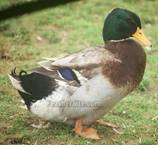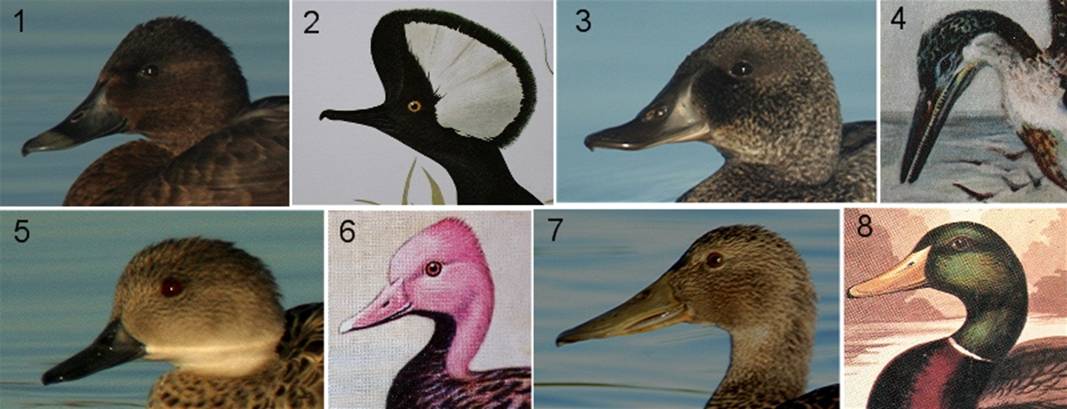I am reproducing the pictures below for
reference purposes. (The original message was only 72kb so I trust
this will not inconvenience anyone). There were 7 entrants, a gratifying
response.
The test fell into 2 parts.
Numbers1, 3, 5 and 7 were all photographed recently on Fyshwick Sewage Ponds,
and are –
1 Hardhead – female (male has white
eye and juv’s is ‘hazel-brown’)
3 Blue-billed Duck – female
5 Grey Teal
7 Australian Shoveler – female
The others were taken from published
drawings.
2 Hooded Merganser –
male. I was surprised that nearly everyone got this, given that the
species is restricted to North America.
The picture shown is from Audubon’s Birds
of America, although no-
one actually mentioned that.
4 Most went for Hesperornis. In fact, hesperornis
was flightless and this is an artist’s imaginative attempt at that other
toothed prehistoric bird, Ichthyornis.
There is lots on the web about both of those chaps, the fossils of which were
discovered in Kansas
in the 1870s. Ichy is said to be about the size of a small gull or tern
and the Sternberg Museum, Kansas, has a mural that suggests a remarkable affinity
with the Silver Gull. Thus: 
I am happy to concede that this is not a
duck, and anyone who is aggrieved by that may score themselves out of 7.
6 is the famous Pink-headed Duck of
northern India,
the picture being by Robert Scholz from an early edition of Salim Ali’s Book of Indian Birds. As there has
been no confirmed sighting since 1935, the species is probably extinct although
some may prefer to follow Rory Nugent’s opinion, as expressed in his The Search for the Pink-headed Duck (1991),
that ‘They’re not extinct, just hard to find’.
8 Here I have
out-smarted myself. The picture is of a Rouen Duck from the cover of Dr J
Batty’s Domesticated Ducks and Geese,
being taken in turn from a painting by JW Ludlow which appeared in the 1870s in
Lewis Wright’s Illustrated Poultry
Book. The Rouen
is a massive bird, said to be the largest domestic duck. This is the fat multi-coloured
drake, sometimes seen around farm ponds, although more often in Europe or North America, This is a more typical view:  .
However, the bird is sometimes referred to as a ‘domesticated mallard’,
and I must concede that my head shot is indistinguishable from a mallard, so ‘Mallard’
will do (although if a tie-breaker were needed, the person who said ‘’That’s
the old Rouen
all right!’ would have to take the prize).
.
However, the bird is sometimes referred to as a ‘domesticated mallard’,
and I must concede that my head shot is indistinguishable from a mallard, so ‘Mallard’
will do (although if a tie-breaker were needed, the person who said ‘’That’s
the old Rouen
all right!’ would have to take the prize).
So, the 2006 Duckhead! Champion is Paul
Taylor who got the lot, even venturing a tentative ‘Ichthyornis?’
to number 4, although he later retracted that after some agonized reflection.
Partly correct answers, or pertinent comments, or semi-relevant witticisms,
were offered by Jochen Brocks, Ian Fraser, Mark
Clayton, Tom Green, Philip Veerman, and Benj Whiworth.


